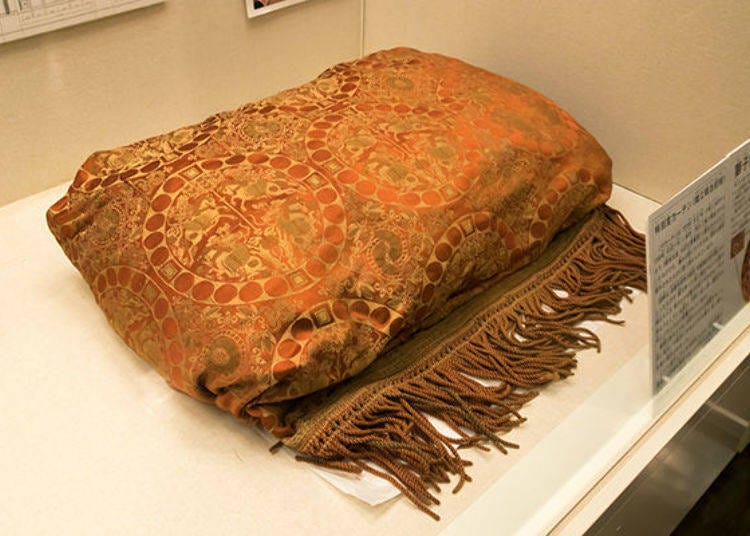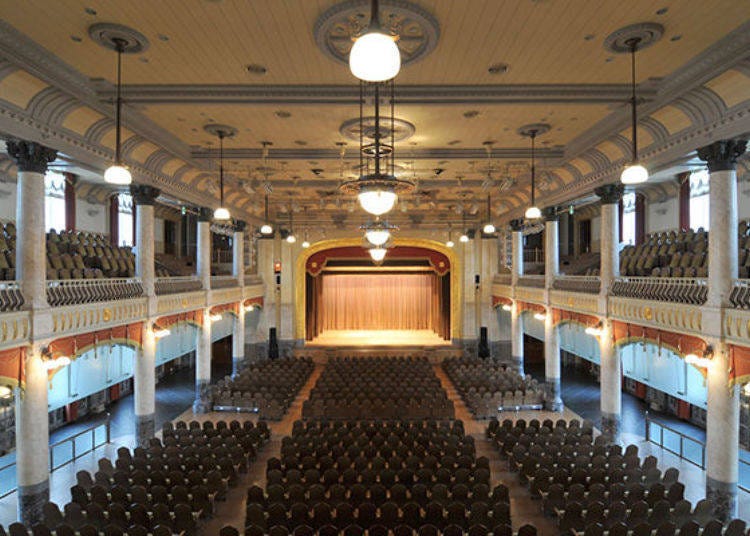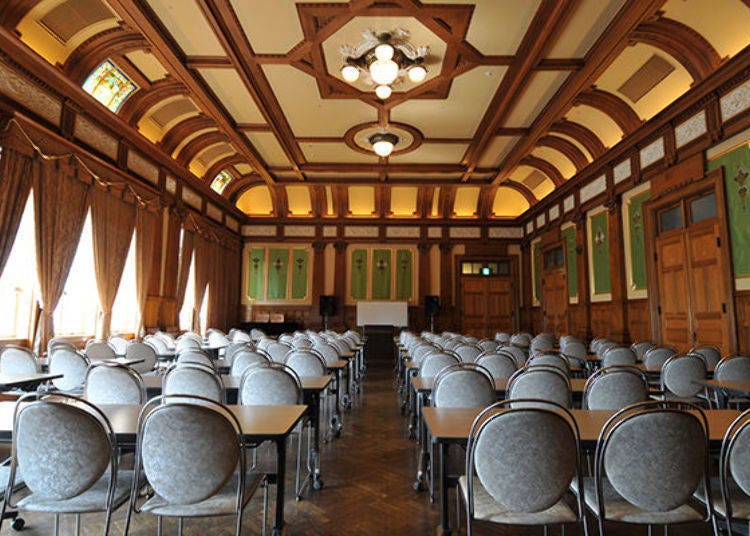
Osaka City Central Public Hall, which celebrated its 100 anniversary in 2018, symbolizes Nakanoshima - a vibrant area dating back to ancient times when Osaka was a thriving merchant city. You’ll find retro buildings here, as well as fashionable cafes and restaurants.
The building is still used as a public facility, and it is designated as an “Important national cultural property” for its artistic looks and architecture. We heard that guided visits of the building are available, including a delicious lunch as part of the tour, so we went along to take a look!
Bright orange brickwork typical of the Nakanoshima area
Nakanoshima is a large sandbank, surrounded by the Dojima River on one side and the Tosabori River on the other.
Every May and October, the roses bloom in various locations around Nakanoshima, such as Nakanoshima Park, Nakanoshima Library, and Nakanoshima Festival Tower. With over 3,000 brightly colored roses dotted around, there’s an air of culture and refinement all around.
This is where Osaka City Central Public Hall is located. It’s about a five-minute walk from Yodoyabashi Station on the subway or a minute’s walk from Naniwa Station on the Keihan Nakanoshima Line.

The building was completed in 1918. It has various rooms inside, including a large meeting hall that can accommodate up to 1,160 people. The Public Hall is full of interesting artistic features, and in 2002 it was designated as an “Important national cultural property.” You can take a guided tour with a staff member to look around the inside of this historic building.
Find out the history behind the Osaka City Central Public Hall with a guided tour!
The tours are held between two and five times a month on specifically designated days. There are two tours per tour day (10:00 AM and 11:00 AM), with each tour taking approximately 30 minutes to go round the building.
There are two options to choose from: either the Basic Course with guided tour only (500 yen incl. tax) or else the Special Course, which includes the tour and an exclusive set lunch (2,000 yen incl. tax).

I’d made an effort to come here for the tour, so I did the Special Course. Then, on the appointed day we gather in the lobby in the basement (floor B1), and we set off, along with the other participants on the Basic Tour.
The group is limited to 25 people in total, and the tour that day was pretty full! There were even some foreigners in our group with their own interpreters.
The Public Hall was built with the help of a donation from an Osaka citizen
The building has three floors and a basement. The large assembly hall on the ground floor has a high ceiling, stretching up two stories.
On the top floor, there are small meeting rooms and a VIP room. The guided tour takes you around the exhibition room in the basement and the VIP room, which is normally out of bounds.
Let’s start the tour!
Many people see the Public Hall from the outside and think to themselves, “This building looks familiar. I feel like I’ve seen this somewhere before.”
Nakamura-san tells me that Kingo Tatsuno, the architect who worked on Tokyo Station, known for its red brickwork, was also involved with designing the Public Hall.

Starting in 1999, repairs were carried out, and the building was restored back to its original state, as well as being updated for modern-day use. The work took three and a half years to complete. Furniture and internal pillars around the building were reused as part of the process.


Articles and photos detailing the Public Hall’s hundred-year history are on display in the exhibition room in the basement.

Einosuke Iwamoto, the building's creator, was an investor on the Osaka stock exchange during the late 19th and early 20th centuries. On a business trip to the US in the early 1930s, he was deeply impressed by how American businessmen provided philanthropic support for public services.
So when he returned to Japan, he donated a million yen to the city of Osaka (equivalent to around 5 to 10 billion yen nowadays). The city decided to use the donation to fund the building of the Central Public Hall.
However, Iwamoto ran into difficulties with his investments and sadly took his own life at the age of 39 before the building was completed.

Numerous concerts by famous artists and celebrity lectures have been held here. “‘Aida’ was performed by a Russian opera group in the Taisho era. Since the Second World War, the Public Hall has hosted events such as a lecture by Helen Keller and a celebration for Yuri Gagarin,” Nakamura-san tells us. Looking at the articles on display in the exhibition room helps you can really appreciate the history of the building.


Nakamura-san tells us, "The role of the hall has gradually changed over the generations. For example, the rooms now used as the intermediate and small meeting halls were originally used for ceremonial dinners and banquets.” We could really feel the passage of history as we look around the exhibition.

When the rooms were used as dining rooms, we’re told that the intermediate meeting hall was reserved for men only and the small meeting room was only for women. That would be unthinkable now, wouldn’t it? Nevertheless, these little snippets are fascinating!
With that, we leave the exhibition room and head up to the third floor.
A VIP room packed full of art works
At last, we enter the VIP room on the third floor. “This room was used as a VIP room when the Public Hall was first built. Nowadays, it’s used for meetings, ceremonies or location shoots," says Nakamura-san.
As soon as we enter, our eyes are drawn to the high ceiling with its beautiful paintings, as well as the large stained glass window. We all let out gasps of wonder and admiration.


The figures painted on the ceiling are gods from Japanese mythology: Izanagi, Izanami, and three deities from the Japanese pantheon, the Amatsukami.
The scene depicts Izanagi and Izanami giving Amanonuboko, the spear given by the Amatsukami for creating land. It was painted by Hisashi Matsuoka, a Western-style painter in the late 19th and first half of the 20th century.


Deities from Japanese mythology also appear in the paintings on the north and south walls.
Nakamura-san tells us that a pair of gods, Susanoonomikoto, the god of trade, and Futodaminomikoto, the god of industry, are painted on the north and south walls respectively as a prayer for prosperity.


Next, we turn our attention to the stained glass. The east-facing window with its fan-shaped stained glass patterns is spectacularly beautiful! It’s made up of 5,000 different pieces of glass.

“There’s a humorous touch hidden somewhere in the design of the stained glass,” says Nakamura-san. “Does anyone know what it is?” she asks.

Apparently, this ribbon is a motif of the miotsukushi symbol of Osaka. The miotsukushi was a sign placed in the sea to mark out the shipping lanes.
Osaka was known as the “Water Capital” because of the many rivers that flow through it, and the miotsukushi was adopted as the emblem of the city during the Meiji era (1868-1912).
If you put your face next to the round-shaped glass...

"There are 224 circle-shaped convex lenses like this,” says Nakamura-san. “Light is diffused as it goes through the window.”



That concludes our 30-minute guided tour. This whole building is like a museum, so I’m continually surprised that it is still actively used for public functions. Events are held here from time to time, even in the rooms we weren’t allowed to today. I would have loved to see inside these.
There's still so much to see! Highlights of the Public Hall
At the end of the tour, visitors doing the “Special Course” are free to walk around the building until lunch at 11.30 (except for the assembly hall and the reserved meeting rooms). So let's look around at some of the things we didn’t get to see on the guided tour.


Because the building is still actively used as a public facility, there are some rooms where visitors are not allowed. If you really want to see them, you should come to one of the concerts or lectures held here.




The building also has an official shop. It features items associated with the Public Hall, as well as specially selected local products, along with fashionable accessories, stationery, and books.




Enjoy lunch at Nakanoshima Social Eat Awake
It’s now 11:30, so we make our way to the lunch venue at the restaurant, “Nakanoshima Social Eat Awake,” in the basement. The restaurant incorporates the building’s red brickwork to good effect, with a stylish interior blending elegance and informality.

The restaurant serves cool and contemporary French and Italian-style cuisine prepared with Japanese ingredients. Even though it’s a weekday, there are plenty of visitors eating lunch. You can have a leisurely meal here with friends or just by yourself.

Tour guide visitors are served a special set lunch. Today’s menu is Potage of Potato followed by the main dish of Kagoshima Kurobuta (Black Pig) Premium Pork Shoulder Chops with Seasonal Roasted Vegetables and a Green Mustard Sauce. The menu includes unlimited bread and one drink each.


Green mustard sauce is a perfect accompaniment for the succulent pork! It’s served with lightly fried vegetables, including potatoes, carrots, and green beans. The warm and soft sweet texture of the vegetables brings out the delicate flavors of the meat and the sauce.
2,000 yen (tax included) for a guided tour and a high-quality lunch like this seems very reasonable to me! The food is of a high standard and unpretentious, but you’ll feel like you’ve had something quite special.
Naturally, you’re welcome to use the restaurant even if you haven’t done the guided tour. A full dinner menu is served in the evening so that you can eat in comfort in a laid-back, grown-up atmosphere.
-
Nakanoshima Social Eat Awake中之島ソーシャルイート アウェイク
- Address 1-1-27 Nakanoshima, Kita-ku, Osaka
- Phone Number 06-6233-9660
Opening hours: Weekdays 11:30AM - 10:30PM (Last order); Saturdays, Sunday and public holidays 11:00AM - 10:30PM (Last order)
Closed: 4th Tuesday of the month (If this is a public holiday, the restaurant will open as usual, and will be closed on the following day)
See the Public Hall lit up in the Feast of Light! Don't miss the excellent concerts here!
The Osaka Central Public Hall is lit up at night all year round, but don’t miss the seasonal illumination events held here.
The Osaka Festival of the Lights, a seasonal winter event, was held from November 12 to December 31, 2017. In addition, the Special Performance Wall Tapestry features beautiful light paintings projected onto the west wall of the Public Hall and is being held from December 14-25.

On December 23, there is a one-off Christmas event, “ONE COIN Tour and Concert 2017.” As well as seeing the large, intermediate and small meeting halls, which you don’t get to see normally on the guided tour, you can enjoy mini-concerts by a 100-strong gospel choir and a symphony orchestra - all for the price of 500 yen (incl. tax).

The Central Public Hall has stood here for over 100 years, fulfilling Einosuke Iwamoto’s wish for the prosperous development of Osaka and Japan itself. The building is packed full of artworks and features by leading artists and artisans, with its retro architecture depicting the ups and downs of its long history over the years.
If you want to try something a little different from the usual entertainment and amusement that Osaka has to offer and to sample the city’s chic and trendy side, then why not visit the Osaka Central Public Hall?
-

-
Address
1-1-27, Nakanoshima, Kita-ku, Osaka-shi, Osaka, 530-0005
View Map -
Nearest Station
Naniwabashi Station (Keihan-nakanoshima Line)
1 minute on foot
- Phone Number 06-6208-2002
-
Address
1-1-27, Nakanoshima, Kita-ku, Osaka-shi, Osaka, 530-0005
Text by:kurashisa
- Area
- Category
*Prices and options mentioned are subject to change.
*Unless stated otherwise, all prices include tax.
Popular Tours & Activitiess
Recommended places for you
-
Goods

Yoshida Gennojo-Roho Kyoto Buddhist Altars
Gift Shops
Nijo Castle, Kyoto Imperial Palace
-

Kanzenkoshitsuyakinikutabehodai Gyugyu Paradise Sannomiya
Yakiniku
Kobe, Sannomiya, Kitano
-

Kambei Sannomiyahonten
Yakiniku
Kobe, Sannomiya, Kitano
-

Kiyomizu-dera Temple
Temples
Gion, Kawaramachi, Kiyomizu-dera Temple
-

ISHIDAYA Hanare
Yakiniku
Kobe, Sannomiya, Kitano
-

Jukuseiniku-to Namamottsuarera Nikubaru Italian Nikutaria Sannomiya
Izakaya
Kobe, Sannomiya, Kitano
-

Kyoto's Hidden Treasures Open This Winter! Enjoy Exclusive Access to 15 Rare Cultural Sites (Jan-Mar 2026)
by: Guest Contributor
-

November Events in Kansai: Fun Festivals, Food, and Things to Do in Kyoto & Osaka
-
Ad

Experiencing Manga as Culture, Not Just Reading It: Expo 2025 with Rumiko Takahashi
-
Ad

Discover Timeless Beauty: Kimono-en, a Web Magazine Exploring the Spirit of Kimono
-

Celebrate a Dreamy Barbapapa Christmas at JR Osaka Station's Twilight
by: Guest Contributor
-
Ad

Recharge and Relax with a Healing Getaway at Kamenoi Hotel Toba
Inspiration for Accommodations
-

Spacious Family Hotel in Namba: 20 Comfortable Stays for Family Fun
-

Charming Hotels to Enjoy the Spectacular Views of Arashiyama's Autumn Leaves from Your Room
-

Experience Stunning Views of Osaka Castle from Private Spaces: Top Hotels Near Osaka Castle
-

Recommended by Visitors! Arashiyama's Best-Rated Hotels
-

Family-Friendly Universal Studios Japan Hotel with Excellent Access
-

Enjoy a Comfortable Stay in Osaka! 10 Hotels with Convenient Airport Shuttle Services
-

Top 10 Recommended Hotels Near Namba Station with Great Access
-

Enjoy Night Views from Your Room! Recommended Hotels in Namba Area
-

What to Pack for Japan: 8 Essential Things for a Hassle-Free Trip
-

Enjoy Kobe’s Historic Charm: A 2-Hour Itinerary for Kitano-cho Ijinkan
-

Highlights of Umeda Sky Building: Get the Perfect Views of Osaka!
-

Sightseeing Around Togetsukyo Bridge: History & Tips for Visiting Kyoto Arashiyama's Iconic Symbol
by: WESTPLAN
-

3 Best Izakaya In Osaka Where You Can Enjoy Drinks and Local Dishes, Recommended by Locals
-

The Best of Japan: 11 Major Cities Every Traveler Should Visit
- #best gourmet Osaka
- #things to do Osaka
- #what to do in kyoto
- #what to bring to japan
- #best gourmet Kyoto
- #new years in Osaka
- #what to buy in nanba
- #Visiting Osaka
- #onsen tattoo friendly arima
- #daiso
- #Visiting Kyoto
- #best japanese soft drinks
- #japanese fashion culture
- #japanese convenience store snacks
- #japanese nail trends













